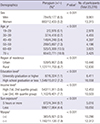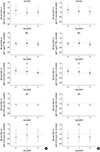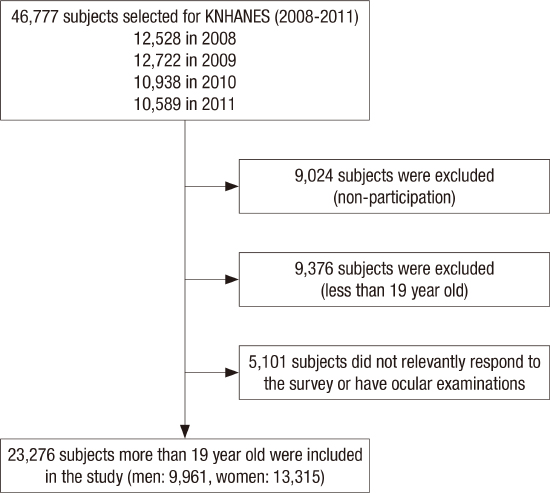1. World Health Organization. WHO Air Quality Guidelines for Particulate Matter, Ozone, Nitrogen Dioxide and Sulfur Dioxide: Global Update 2005. Geneva: World Health Organization;2006.
2. Kampa M, Castanas E. Human health effects of air pollution. Environ Pollut. 2008; 151:362–367.
3. Hwang SH, Choi YH, Paik HJ, Wee WR, Kim MK, Kim DH. Potential importance of ozone in the association between outdoor air pollution and dry eye disease in South Korea. JAMA Ophthalmol. 2016; 134:503–510.
4. Livingston PM, McCarty CA, Taylor HR. Visual impairment and socioeconomic factors. Br J Ophthalmol. 1997; 81:574–577.
5. Hill JC, Maske R. Pathogenesis of pterygium. Eye (Lond). 1989; 3:218–226.
6. Marmamula S, Khanna RC, Rao GN. Population-based assessment of prevalence and risk factors for pterygium in the South Indian state of Andhra Pradesh: the Andhra Pradesh eye disease study. Invest Ophthalmol Vis Sci. 2013; 54:5359–5366.
7. Rim TH, Nam J, Kim EK, Kim TI. Risk factors associated with pterygium and its subtypes in Korea: the Korean National Health and Nutrition Examination Survey 2008-2010. Cornea. 2013; 32:962–970.
8. Tano T, Ono K, Hiratsuka Y, Otani K, Sekiguchi M, Konno S, Kikuchi S, Onishi Y, Takegami M, Yamada M, et al. Prevalence of pterygium in a population in Northern Japan: the locomotive syndrome and health outcome in Aizu cohort study. Acta Ophthalmol. 2013; 91:e232–6.
9. Zhao L, You QS, Xu L, Ma K, Wang YX, Yang H, Jonas JB. 10-year incidence and associations of pterygium in adult Chinese: the Beijing eye study. Invest Ophthalmol Vis Sci. 2013; 54:1509–1514.
10. Lim CY, Kim SH, Chuck RS, Lee JK, Park CY. Risk factors for pterygium in Korea: the Korean National Health and Nutrition Examination Survey V, 2010-2012. Medicine (Baltimore). 2015; 94:e1258.
11. Welty LJ, Peng RD, Zeger SL, Dominici F. Bayesian distributed lag models: estimating effects of particulate matter air pollution on daily mortality. Biometrics. 2009; 65:282–291.
12. Lim YH, Kim H, Kim JH, Bae S, Park HY, Hong YC. Air pollution and symptoms of depression in elderly adults. Environ Health Perspect. 2012; 120:1023–1028.
13. Dabass A, Talbott EO, Venkat A, Rager J, Marsh GM, Sharma RK, Holguin F. Association of exposure to particulate matter (PM2.5) air pollution and biomarkers of cardiovascular disease risk in adult NHANES participants (2001-2008). Int J Hyg Environ Health. 2016; 219:301–310.
14. Liu T, Liu Y, Xie L, He X, Bai J. Progress in the pathogenesis of pterygium. Curr Eye Res. 2013; 38:1191–1197.
15. Bradley JC, Yang W, Bradley RH, Reid TW, Schwab IR. The science of pterygia. Br J Ophthalmol. 2010; 94:815–820.
16. Chui J, Di Girolamo N, Wakefield D, Coroneo MT. The pathogenesis of pterygium: current concepts and their therapeutic implications. Ocul Surf. 2008; 6:24–43.
17. Coroneo MT. Pterygium as an early indicator of ultraviolet insolation: a hypothesis. Br J Ophthalmol. 1993; 77:734–739.
18. Poljšak B, Fink R. The protective role of antioxidants in the defence against ROS/RNS-mediated environmental pollution. Oxid Med Cell Longev. 2014; 2014:671539.
19. Ozsutcu M, Arslan B, Erdur SK, Gulkilik G, Kocabora SM, Muftuoglu O. Tear osmolarity and tear film parameters in patients with unilateral pterygium. Cornea. 2014; 33:1174–1178.
20. Ishioka M, Shimmura S, Yagi Y, Tsubota K. Pterygium and dry eye. Ophthalmologica. 2001; 215:209–211.
21. Rajiv MS, Mithal S, Sood AK. Pterygium and dry eye--a clinical correlation. Indian J Ophthalmol. 1991; 39:15–16.
22. Kaufman SC, Jacobs DS, Lee WB, Deng SX, Rosenblatt MI, Shtein RM. Options and adjuvants in surgery for pterygium: a report by the American Academy of Ophthalmology. Ophthalmology. 2013; 120:201–208.
23. Han SB, Jeon HS, Kim M, Lee SJ, Yang HK, Hwang JM, Kim KG, Hyon JY, Wee WR. Risk factors for recurrence after pterygium surgery: an image analysis study. Cornea. 2016; 35:1097–1103.
24. Sul S, Korkmaz Ş, Novruzlu Ş. Seasonal effects on pterygium surgery outcome: implications for the role of sunlight exposure. Cornea. 2014; 33:504–506.
25. Cutolo M, Wilder RL. Different roles for androgens and estrogens in the susceptibility to autoimmune rheumatic diseases. Rheum Dis Clin North Am. 2000; 26:825–839.










 PDF
PDF ePub
ePub Citation
Citation Print
Print





 XML Download
XML Download